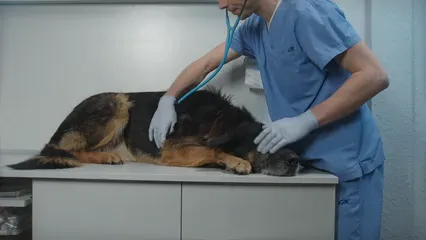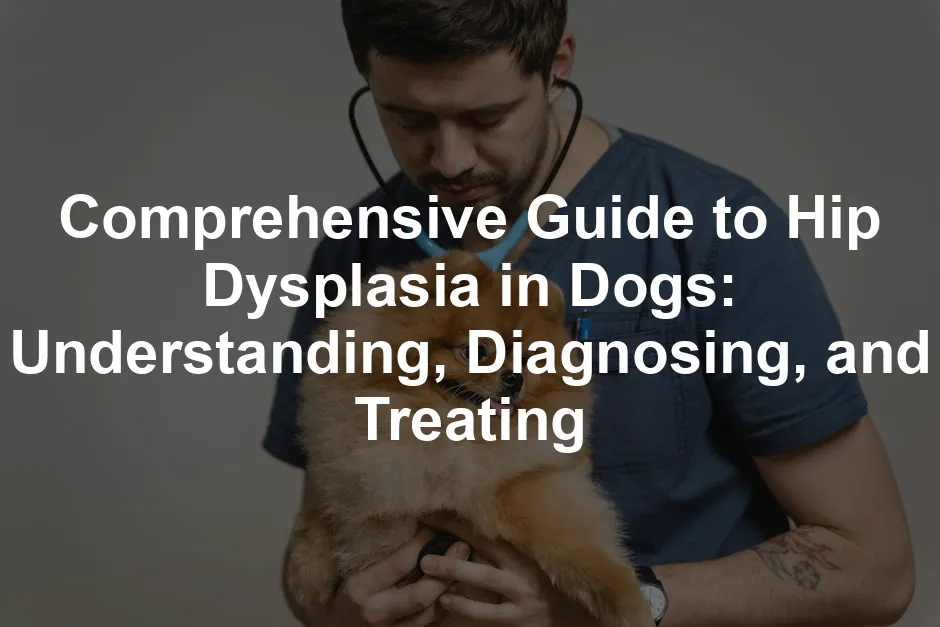Introduction
Hip dysplasia is a prevalent orthopedic issue in dogs. This condition often affects large breeds but can occur in any dog. It is primarily genetic, influencing the overall quality of life. Early detection and treatment are crucial for managing symptoms and improving your dog’s well-being.
Summary and Overview
Hip dysplasia refers to the improper formation of the hip joint. This abnormality results in joint instability, leading to pain and mobility challenges. The hip joint’s structure is a ball-and-socket mechanism, which, when misaligned, causes friction and wear over time. Large breeds, like German Shepherds and Labradors, are most frequently affected. Without intervention, dogs may suffer from severe pain and limited movement. This guide will cover the causes, symptoms, diagnosis, treatment options, and prevention strategies associated with hip dysplasia.
To support your dog’s joint health, consider adding a Glucosamine Chondroitin Joint Supplement for Dogs to their diet. This supplement can help maintain joint function, reduce inflammation, and provide your furry friend with the comfort they deserve.

Understanding Canine Hip Dysplasia
What Is Hip Dysplasia?
Hip dysplasia is a genetic condition that manifests during a dog’s growth. It involves the abnormal formation of the hip joint. In a healthy hip, the femoral head fits snugly into the acetabulum. However, in dysplastic hips, this fit is loose, resulting in joint instability. This instability leads to friction, cartilage damage, and eventually arthritis.
Statistics show that hip dysplasia affects many large breeds, with varying prevalence rates. For example, nearly 20% of German Shepherds and 15% of Labradors are known to suffer from this issue. Symptoms can appear as early as a few months old but are often not noticed until dogs are older.
If you’ve noticed any unusual behaviors in your dog, such as difficulty in rising or unusual walking patterns, consider sharing your experiences or symptoms in the comments. Your insights could help others recognize similar issues in their pets!
Causes of Hip Dysplasia
Hip dysplasia is primarily a hereditary condition. Certain breeds, like German Shepherds and Labradors, are more susceptible. Genetic studies show a strong correlation between these breeds and hip dysplasia prevalence. It’s essential to recognize the genetic aspect, as it significantly influences the likelihood of developing this condition.
However, genetics isn’t the only player. Environmental factors also contribute. A puppy’s diet, growth rate, and exercise routine affect their bone development. For instance, overfeeding can lead to excessive weight gain. This added weight stresses the joints, increasing the risk of hip dysplasia. Puppies benefit from a balanced diet tailored for their breed. This helps control growth rates and supports healthy joints.
Obesity plays a critical role too. Dogs that are overweight face higher chances of developing hip issues. Keeping your dog at an ideal weight is vital for preventing joint problems later in life. If you suspect your dog is at risk, consult a veterinarian. They can provide breed-specific advice and dietary recommendations. You might also consider a Dog Weight Management Food to help keep your pup fit and healthy!

Symptoms of Hip Dysplasia
Recognizing hip dysplasia symptoms early can greatly enhance your dog’s quality of life. One common sign is decreased activity. If your dog seems less eager to play or go for walks, it might indicate discomfort.
Another symptom to watch for is difficulty rising or jumping. Is your dog struggling to get up from a lying position? This could point to hip issues. Pay attention to their gait as well. A “bunny hopping” movement, where both back legs move together, can indicate hip dysplasia.
Lameness is also prevalent in affected dogs. You might notice limping or reluctance to climb stairs. Some dogs may even exhibit stiffness after resting. Symptoms can appear as early as six months, though many dogs show signs later. Keeping a symptom diary can be helpful. Note any changes in behavior or mobility. This information can guide discussions with your vet for a proper diagnosis.
Diagnosing Hip Dysplasia
Diagnosing hip dysplasia involves a thorough veterinary examination. Initially, a veterinarian will conduct a physical assessment. This includes observing your dog’s gait and mobility. They may perform the Ortolani test. This physical exam checks for hip joint looseness.
X-rays are crucial for confirming the diagnosis. They allow vets to visualize joint structures and assess any abnormal changes. Radiographic evaluations help determine the severity of the condition. Different diagnostic methods have varying accuracy levels. For instance, PennHIP and OFA protocols are commonly used for assessing hip dysplasia.
Regular veterinary check-ups are essential, especially for at-risk breeds. Early detection can lead to better management strategies. If your dog shows signs of hip dysplasia, don’t hesitate to schedule an appointment with your vet. They can recommend the best course of action based on your dog’s specific needs.

Treatment Options for Hip Dysplasia
Non-Surgical Treatments
Managing hip dysplasia often starts with non-surgical approaches. First, weight management is essential. Keeping your dog at a healthy weight reduces stress on their joints. Consider feeding smaller, measured meals to help control weight gain. Regular vet check-ups can guide you on the best diet plan.
Joint supplements can also help maintain canine joint health. Ingredients like glucosamine, chondroitin, and omega-3 fatty acids support joint function. Pain relief medications, like non-steroidal anti-inflammatory drugs (NSAIDs), can ease discomfort. Always consult your vet before starting any medication. For added omega-3 benefits, consider giving your dog Omega-3 Fish Oil for Dogs to help reduce inflammation and support joint health.
Physical therapy offers another valuable treatment option. This might include exercises tailored to improve strength and flexibility. Hydrotherapy is particularly effective, as it provides low-impact exercise. Studies have shown that combining these non-surgical methods can significantly enhance your dog’s quality of life. If your dog is diagnosed with hip dysplasia, consult your veterinarian to create a personalized treatment plan.

Surgical Treatments
For severe cases of hip dysplasia, surgical options may be necessary. Total hip replacement (THR) is a common procedure. This surgery involves replacing the damaged hip joint with an artificial one. Success rates for THR can be as high as 90-95%, allowing dogs to regain mobility and live comfortably. For more information on surgical options, you can read about comparing surgical and nonsurgical treatments for hip dysplasia in dogs.
Understanding the differences between surgical and nonsurgical treatments is crucial for making informed decisions about your dog’s care. comparing surgical and nonsurgical treatments for hip dysplasia in dogs
Another option is the femoral head ostectomy (FHO). In this procedure, the femoral head is removed to alleviate pain. This creates a false joint, which can help smaller dogs find relief. It’s important to note that recovery includes rehabilitation efforts to maximize the benefits of surgery.
Post-operative care is crucial for any surgical treatment. Follow your veterinarian’s guidance on restricted activity and rehabilitation exercises. By understanding the available surgical options and their success rates, you can make informed decisions. Feel free to share your experiences or thoughts on surgical treatments in the comments!

Preventing Hip Dysplasia
Preventing hip dysplasia starts with responsible breeding practices. Ensure you research breeders who screen for this condition. Additionally, focus on maintaining a balanced diet for puppies. Proper nutrition during their growth phase can greatly influence joint health. Controlled exercise is also essential. Avoid high-impact activities that can stress developing joints.
Studies indicate that a well-managed diet and exercise plan significantly reduce the risk of hip dysplasia. Regular vet visits can help monitor your dog’s development. If you’re considering a puppy, ask breeders about their health screening practices. A little diligence now can lead to healthier joints in your future furry friend! You might also want to check out a Canine Hip Dysplasia Book for more insights into prevention and care.

Prognosis and Long-Term Management
Dogs diagnosed with hip dysplasia can still lead happy lives. With appropriate treatment, many experience significant quality of life improvements. Treatments can include weight management, joint supplements, and physical therapy. These can help alleviate pain and enhance mobility.
Ongoing care is crucial. Regular veterinary check-ups allow for monitoring of your dog’s condition. Adjustments to treatment plans may be necessary over time. It’s essential to pay attention to any changes in your dog’s behavior or mobility.
Statistics show that dogs with managed hip dysplasia can live comfortably for many years. While some may develop arthritis later in life, proactive care can delay or lessen its severity. Engaging in moderate exercise and maintaining a healthy weight are vital for long-term success. For more information on managing joint pain and arthritis, check out our article on the best supplements for dogs with joint pain and arthritis.
Managing joint pain and arthritis is essential for improving your dog’s quality of life. best supplements for dogs with joint pain and arthritis
For the latest insights and updates on pet health, consider subscribing to pet health newsletters. Staying informed can empower you to provide the best care for your furry friend. You might also want to keep your pet’s health in check with a Dog Health Monitoring Device to track their activity and health metrics.

Conclusion
Understanding hip dysplasia in dogs is essential for every pet owner. Regular veterinary care plays a vital role in managing this condition. Responsible pet ownership involves being proactive about your dog’s health. By staying vigilant and informed, you can ensure a better quality of life for dogs affected by hip dysplasia.
FAQs
What breeds are most at risk for hip dysplasia?
Certain breeds are more prone to hip dysplasia. These include German Shepherds, Labradors, Golden Retrievers, and Saint Bernards. Larger breeds are generally at higher risk. It’s essential to screen these breeds early. Regular veterinary check-ups can help identify potential issues before they worsen. Responsible breeding practices also play a crucial role in reducing the incidence of hip dysplasia in these breeds.
How can I tell if my dog has hip dysplasia?
Noticing symptoms early is vital. Common signs include stiffness, difficulty getting up, and decreased activity. You might also see a “bunny hopping” gait or reluctance to climb stairs. If your dog shows these signs, consult your vet for a thorough examination. Early diagnosis can lead to better management strategies and improved quality of life.
What are the treatment options for hip dysplasia?
Treatment varies based on severity. Non-surgical options include weight management, joint supplements, and physical therapy. Pain relief medications can also help. For severe cases, surgical options like total hip replacement or femoral head ostectomy might be necessary. Always discuss the best treatment plan with your veterinarian.
Can hip dysplasia be cured?
Hip dysplasia cannot be cured, but it can be managed. With proper treatment, many dogs live comfortable lives. Regular vet visits help monitor the condition and adjust treatments as needed. Focus on weight management and a tailored exercise plan for your dog’s needs. This proactive approach can significantly enhance their quality of life.
How can I prevent hip dysplasia in my puppy?
Preventing hip dysplasia starts with responsible breeding. Choose breeders who screen for this condition. Additionally, provide a balanced diet to support healthy growth. Avoid over-exercising puppies, especially during their early development. Keeping your puppy at a healthy weight also lowers the risk of developing hip dysplasia later in life.
For those of you interested in keeping your dog safe during water activities, don’t forget to look into a Dog Life Jacket for those summer adventures!
Please let us know what you think about our content by leaving a comment down below!
Thank you for reading till here 🙂
All images from Pexels





